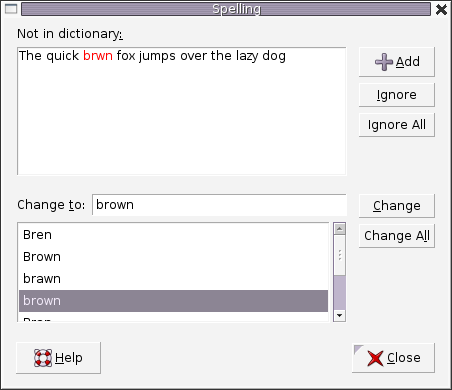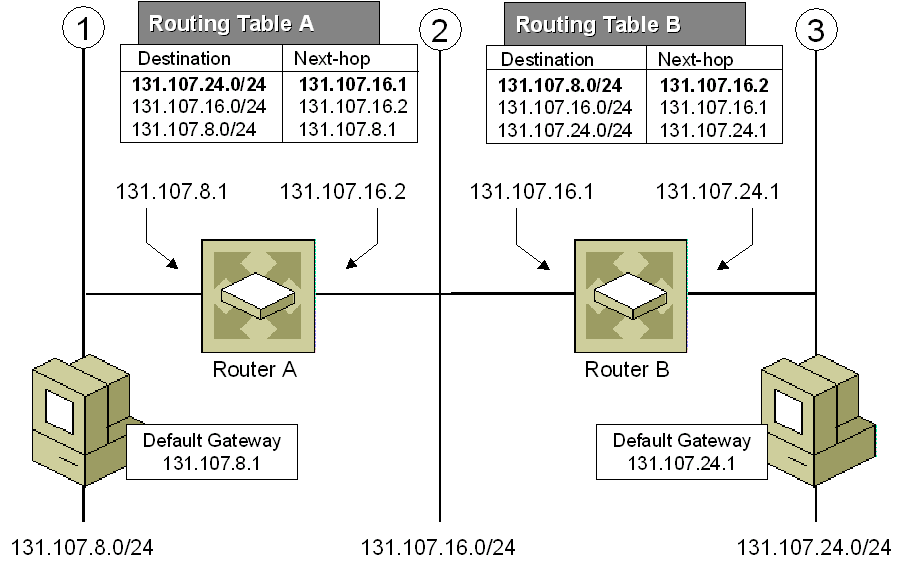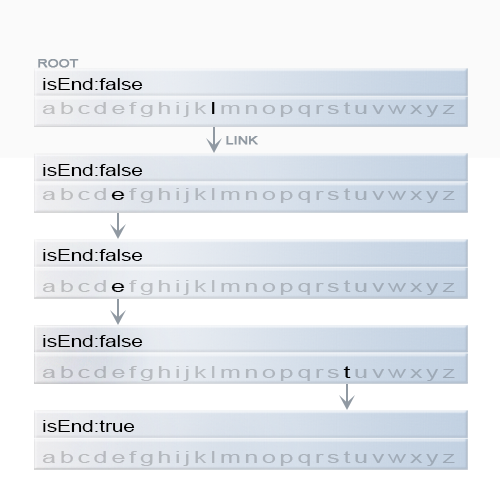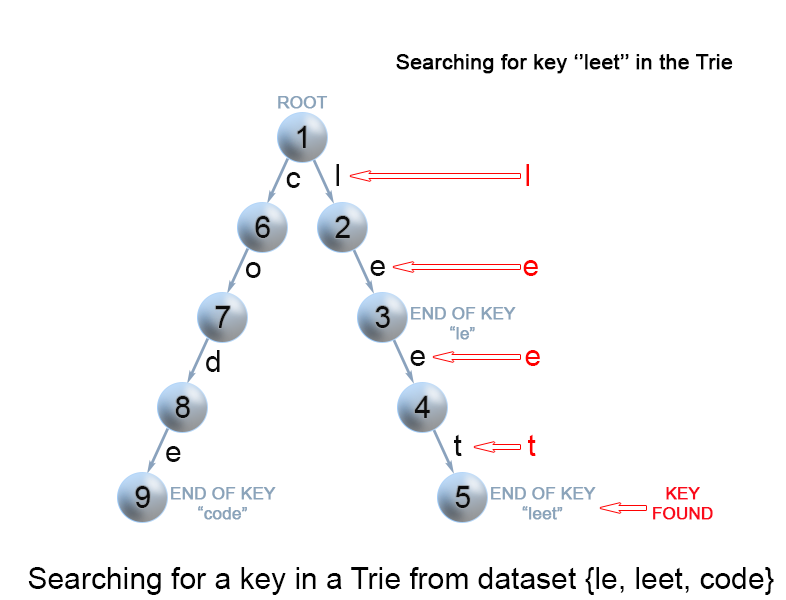Trie,音同try,又叫字典树、前缀树、单词查找树。用于检索字符串数据集中的键。
应用场景
此数据结构有多种应用:
- 自动补全

- 拼写检查

- IP路由(最长前缀匹配)

- 九宫格输入法打字预测

优点
还有其他的数据结构,如平衡树和哈希表,能够在字符串数据集中搜索单词。为什么我们还需要 Trie 树呢?尽管哈希表可以在 间内寻找键值,却无法高效的完成以下操作:
- 找到具有同一前缀的全部键值。
- 按词典序枚举字符串的数据集。
Trie 树优于哈希表的另一个理由是,随着哈希表大小增加,会出现大量的冲突,时间复杂度可能增加到 ,其中 n 是插入的键的数量。与哈希表相比,Trie 树在存储多个具有相同前缀的键时可以使用较少的空间。此时 Trie 树只需要
的时间复杂度,其中 m 为键长。而在平衡树中查找键值需要
时间复杂度。
Trie树的结构
Trie 树是一个有根的树,其结点具有以下字段:
- 最多 R 个指向子结点的链接,其中每个链接对应字母表数据集中的一个字母(假定 R 为 26,小写拉丁字母的数量)。
- 布尔字段,以指定节点是对应键的结尾还是只是键前缀。
向Trie树中插入键
通过搜索 Trie 树来插入一个键。从根开始搜索它对应于第一个键字符的链接。有两种情况:
- 链接存在。沿着链接移动到树的下一个子层。算法继续搜索下一个键字符。
- 链接不存在。创建一个新的节点,并将它与父节点的链接相连,该链接与当前的键字符相匹配。
重复以上步骤,直到到达键的最后一个字符,然后将当前节点标记为结束节点,算法完成。如图所示,将三个单词(le、leet、code)构造Trie树:
复杂度分析
时间复杂度:
,其中 m 为键长。在算法的每次迭代中,我们要么检查要么创建一个节点,直到到达键尾。只需要 m 次操作。
空间复杂度:
。最坏的情况下,新插入的键和 Trie 树中已有的键没有公共前缀。此时需要添加 m 个结点,使用
空间。
在Trie树中查找键
每个键在 trie 中表示为从根到内部节点或叶的路径。用第一个键字符从根开始,检查当前节点中与键字符对应的链接。有两种情况:
- 存在链接。移动到该链接后面路径中的下一个节点,并继续搜索下一个键字符。
- 不存在链接。若已无键字符,且当前结点标记为 isEnd,则返回 true。否则有两种可能,均返回 false :
- 还有键字符剩余,但无法跟随 Trie 树的键路径,找不到键。
- 没有键字符剩余,但当前结点没有标记为 isEnd。也就是说,待查找键只是Trie树中另一个键的前缀。
复杂度分析
- 时间复杂度:
。算法每一步都要搜索下一个键字符。最坏情况需要m次操作
-
查找Trie树中的键前缀
该方法与在 Trie 树中搜索键时使用的方法非常相似。从根遍历 Trie 树,直到键前缀中没有字符,或者无法用当前的键字符继续 Trie 中的路径。与上面提到的“搜索键”算法唯一的区别是,到达键前缀的末尾时,总是返回 true。我们不需要考虑当前 Trie 节点是否用 “isend” 标记,因为搜索的是键的前缀,而不是整个键。例如,下面是查找前缀
co:
复杂度分析
时间复杂度:
- 空间复杂度:
代码实现
Python
class Node:def __init__(self):self.child = [None for _ in range(26)]self.isEnd = Falsedef contain_key(self,ch):return self.child[ord(ch)-ord('a')]def get(self,ch):return self.child[ord(ch)-ord('a')]def put(self,ch):self.child[ord(ch)-ord('a')] = Node()class Trie:def __init__(self):"""Initialize your data structure here."""self.root = Node()def insert(self, word: str) -> None:"""Inserts a word into the trie."""p = self.rootfor i in word:if not p.contain_key(i):p.put(i)p = p.get(i)p.isEnd = Truedef search(self, word: str) -> bool:"""Returns if the word is in the trie."""p = self.rootfor i in word:if not p.contain_key(i):return Falseelse:p = p.get(i)return p.isEnddef startsWith(self, prefix: str) -> bool:"""Returns if there is any word in the trie that starts with the given prefix."""p = self.rootfor i in prefix:if not p.contain_key(i):return Falseelse:p = p.get(i)return True# Your Trie object will be instantiated and called as such:# obj = Trie()# obj.insert(word)# param_2 = obj.search(word)# param_3 = obj.startsWith(prefix)
JavaScript
/**
* Initialize your data structure here.
*/
var TrieNode = function (val) {
// 当前节点的值
this.val = val
// 当前节点是否为某个单词的最后一个字母,若是,则代表是一个单词
this.isWord = false
// 子节点
this.children = new Map()
}
var Trie = function() {
this.root = new TrieNode(null)
};
/**
* Inserts a word into the trie.
* @param {string} word
* @return {void}
*/
Trie.prototype.insert = function(word) {
let cur = this.root
const len = word.length
// 将单词插入到树中
for (let i = 0; i < len; i++) {
const char = word[i]
if (!cur.children.has(char)) {
cur.children.set(char, new TrieNode(char))
}
cur = cur.children.get(char)
// 遍历到结尾的时候将 isWord 设为 true
if (i === len - 1) {
cur.isWord = true
}
}
};
/**
* Returns if the word is in the trie.
* @param {string} word
* @return {boolean}
*/
Trie.prototype.search = function(word) {
let cur = this.root
for (let char of word) {
// 如果该字符不在 children 中,说明是新单词
if (!cur.children.has(char)) {
return false
}
cur = cur.children.get(char)
}
// 若顺利遍历完该单词,则进行判断该单词最后一个字母所在节点的 isWord 是否为真
// 因为存在 key(未插入) / keyword(已插入) 这种情况
return cur.isWord
};
/**
* Returns if there is any word in the trie that starts with the given prefix.
* @param {string} prefix
* @return {boolean}
*/
Trie.prototype.startsWith = function(prefix) {
// 与 search 方法相比,该方法只需要判断能否成功遍历所有字符
let cur = this.root
for (let char of prefix) {
if (!cur.children.has(char)) {
return false
}
cur = cur.children.get(char)
}
return true
};



